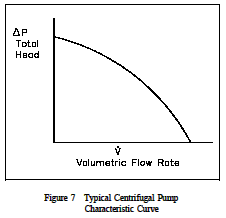Operational Characteristics of a Centrifugal Pump
Fluid Flow Table of Contents
Hydraulic and Pneumatic Knowledge
Operational Characteristics of a Centrifugal Pump
Operational Characteristics of a Centrifugal Pump - Normally, a centrifugal pump produces a relatively low pressure increase in the fluid. This pressure increase can be anywhere from several dozen to several hundred psid across a centrifugal pump with a single stage impeller. The term PSID (Pounds Force Per Square Inch Differential) is equivalent to DP. In this context, it is the pressure difference between the suction and discharge of a pump. PSID can also be used to describe a pressure drop across a system component (strainers, filters, heat exchangers, valves, demineralizers, etc.). When a centrifugal pump is operating at a constant speed, an increase in the system back pressure on the flowing stream causes a reduction in the magnitude of volumetric flow rate that the centrifugal pump can maintain.
Analysis of the relationship between the volumetric flow rate ( ) that a centrifugal ˙V pump can maintain and the pressure differential across the pump (DPpump) is based on various physical characteristics of the pump and the system fluid. Variables evaluated by design engineers to determine this relationship include the pump efficiency, the power supplied to the pump, the rotational speed, the diameter of the impeller and blading, the fluid density, and the fluid viscosity. The result of this complicated analysis for a typical centrifugal pump operating at one particular speed is illustrated by the graph below.

Pump head, on the vertical axis, is the difference between system back pressure and the inlet pressure of the pump (DPpump). Volumetric flow rate (V ), on the horizontal axis, is the rate at which fluid is flowing through the pump. The graph assumes one particular speed (N) for the pump impeller.